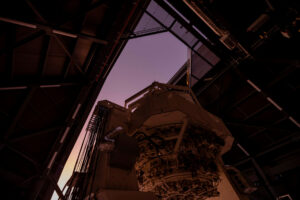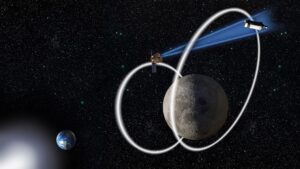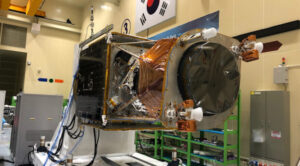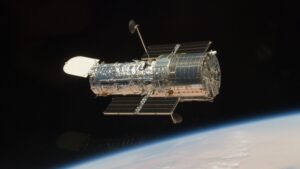Connecting the Countryside
Saturday, 01 October 2022 09:14
Because most people live in cities and suburbs, broadband and mobile service tend to be good there. But not everyone everywhere has the same opportunities.
The post Connecting the Countryside appeared first on SpaceNews.
NASA eyes November for launch attempt of Moon rocket
Saturday, 01 October 2022 05:31

The US space agency, which was forced to postpone its latest liftoff attempt due to massive Hurricane Ian which hammered Florida this week, announced it was preparing its next launch window for between November 12 and November 27.
"Over the coming days," NASA said in a blog post, the team will assess conditions and necessary work and "identify a specific date for the next launch attempt."
Officials had so far refused to completely shut the door on an earlier attempt in October.
The SLS rocket, the most powerful ever designed by NASA, had to be returned to its storage hangar at Kennedy Space Center on Tuesday in order to shelter it from the approach of Hurricane Ian.
The storm devastated parts of Florida but the rocket itself suffered no damage, NASA said.
Planning efforts for the November launch window will allow "time for employees at Kennedy to address the needs of their families and homes after the storm" and in the run up to the next mission attempt.
Office of Space Commerce: FCC “aggressively” pushing limits of authority with orbital debris rule
Friday, 30 September 2022 22:50
The FCC’s adoption of a new rule for disposal of low Earth orbit satellites is well-intentioned but pushing the limits of its authority, says the director of the Office of Space Commerce.
The post Office of Space Commerce: FCC “aggressively” pushing limits of authority with orbital debris rule appeared first on SpaceNews.
US candidate to be first woman to lead UN telecoms agency
Friday, 30 September 2022 20:01
Doreen Bogdan-Martin will become the first woman to head the U.N.’s telecoms agency in its 157-year history from January, and the first American in the role since the 1960s after beating a Russian leadership challenge.
Space surveillance telescope developed by the U.S. begins operations in Australia
Friday, 30 September 2022 16:42
The Space Surveillance Telescope, declared operational Sept. 30, will join the network of sensors used by the United States, Australia and other allies to track objects in orbit
National Space Council to seek industry input on future regulatory framework
Friday, 30 September 2022 15:33
The National Space Council plans to hold “learning sessions” with industry in coming weeks on how to develop a new regulatory framework for novel commercial space activities.
The post National Space Council to seek industry input on future regulatory framework appeared first on SpaceNews.
Tents for Industry Space Days
Friday, 30 September 2022 14:50 Image:
Tents for Industry Space Days
Image:
Tents for Industry Space Days Venus: The trouble with sending people there
Friday, 30 September 2022 14:27
Venus, often called Earth's "evil twin" planet, formed closer to the sun and has since evolved quite differently from our own planet. It has a "runaway" greenhouse effect (meaning heat is completely trapped), a thick carbon-dioxide-rich atmosphere, no magnetic field and a surface hot enough to melt lead.
Several uncrewed scientific missions will study how and why that happened in the next decade. But now some scientists want to send a crewed mission there as well for a flyby. Is that a good idea?
With a slightly smaller diameter than Earth, Venus orbits closer to the sun. This means that any water on the surface would have evaporated shortly after its formation, starting its greenhouse effect. Early and sustained volcanic eruptions created lava plains and increased the carbon dioxide in the atmosphere—starting the runaway greenhouse effect, which increased the temperature from just a little higher than Earth's to its current high value of 475°C.
While the Venus year is shorter than ours (225 days), its rotation is very slow (243 days) and "retrograde"—the other way round to Earth. The slow rotation is related to a lack of magnetic field, resulting in a continuing loss of atmosphere.
Space Force studying requirements for cislunar space domain awareness
Friday, 30 September 2022 14:21
The Space Force expects to know by next spring what capabilities it will need to carry out space domain awareness activities in cislunar space.
The post Space Force studying requirements for cislunar space domain awareness appeared first on SpaceNews.
Europe’s space industry gathers at ESA
Friday, 30 September 2022 13:45
ESA welcomed a record 1700 visitors from 800 companies and institutions to its Industry Space Days event on 28–29 September at ESTEC, its technical centre in The Netherlands. It is a place where industry can meet and share their ideas for new emerging uses of space and commercial potential.
Week in images: 26-30 September 2022
Friday, 30 September 2022 12:07
Week in images: 26-30 September 2022
Discover our week through the lens
South Korea seeks $32.9 million to launch satellites grounded by Russia sanctions
Friday, 30 September 2022 11:34
SEOUL, South Korea — South Korea’s science ministry plans to set aside 47.2 billion won ($32.9 million) in next year’s budget to launch two satellites that have been left grounded because of Western sanctions on Russia over the war in Ukraine.
NASA and SpaceX to study possible private Hubble servicing mission
Friday, 30 September 2022 11:30
NASA and SpaceX announced Sept. 29 they will study a concept to send a Crew Dragon spacecraft to reboost, and possibly service, the Hubble Space Telescope to extend its life.
The post NASA and SpaceX to study possible private Hubble servicing mission appeared first on SpaceNews.
Satellite Vu signs SpaceX launch contract to deploy thermal monitoring capabilities
Friday, 30 September 2022 10:17 British Earth Observation company, Satellite Vu has signed a second SpaceX launch contract for their second satellite, doubling their thermal data collection capacity, faster than planned, amidst rising climate concerns.
The deal will see Satellite Vu's unique Mid-wave Infrared (MWIR) imaging satellite launched into Sun-synchronous orbit (SSO) aboard a Falcon 9 rocket in early 2024. The sa
British Earth Observation company, Satellite Vu has signed a second SpaceX launch contract for their second satellite, doubling their thermal data collection capacity, faster than planned, amidst rising climate concerns.
The deal will see Satellite Vu's unique Mid-wave Infrared (MWIR) imaging satellite launched into Sun-synchronous orbit (SSO) aboard a Falcon 9 rocket in early 2024. The sa Asteroid that formed Vredefort crater bigger than previously believed
Friday, 30 September 2022 10:17 About two billion years ago, an impactor hurtled toward Earth, crashing into the planet in an area near present-day Johannesburg, South Africa. The impactor-most likely an asteroid-formed what is today the biggest crater on our planet.
Scientists have widely accepted, based on previous research, that the impact structure, known as the Vredefort crater, was formed by an object about 15 kilo
About two billion years ago, an impactor hurtled toward Earth, crashing into the planet in an area near present-day Johannesburg, South Africa. The impactor-most likely an asteroid-formed what is today the biggest crater on our planet.
Scientists have widely accepted, based on previous research, that the impact structure, known as the Vredefort crater, was formed by an object about 15 kilo 
